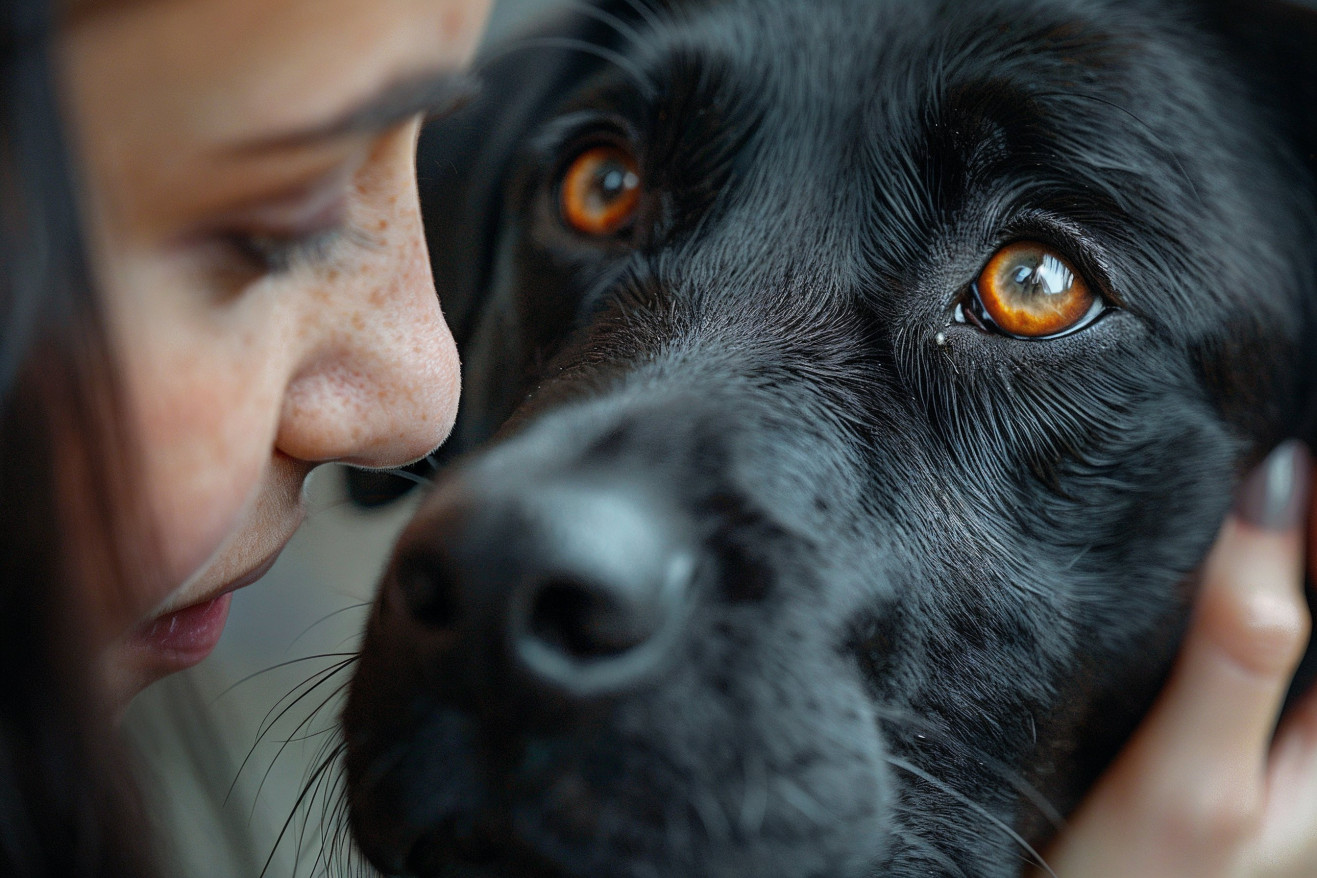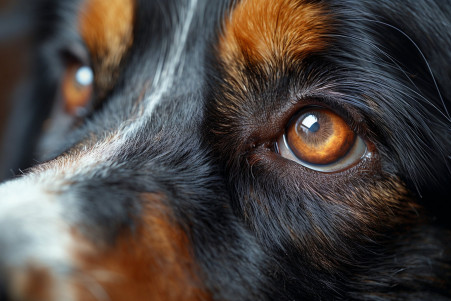White Spots on a Dog’s Eye: Causes and Treatments
4 March 2024 • Updated 4 March 2024

If you’ve noticed a white spot on your dog’s eye, you’re probably concerned and wondering what it could mean. White spots on a dog’s eye can be caused by a number of things, including cataracts, corneal dystrophy, nuclear sclerosis, and keratitis.
It’s important to get your dog to the vet as soon as possible so they can diagnose the issue and get your dog the treatment they need, which may include medication, surgery, or other medical interventions.
In this article, we’ll take a deep dive into veterinary studies and clinical research to learn about the different causes of white spots on a dog’s eye. We’ll also cover how these issues are diagnosed, what treatments are available, and how nutrition and other factors play a role in eye health and care, using information from veterinary ophthalmology experts.
Our goal is to give you a well-rounded view of this condition so you can better understand it and know what to do to help your dog stay healthy.
What causes white spots on a dog's eye and how are they treated?
Getting to the Root of the Problem: Diagnostics for Canine Eye Conditions
If your dog has a white spot in their eye, your vet will start by conducting a comprehensive ophthalmic examination. According to VIN, watching the patient’s behavior, evaluating the patient’s gait, and observing the patient’s responses to hand motion and direct and indirect pupillary light reflexes can give your vet some information about the patient’s vision.
This is then followed by a complete physical examination, which includes evaluating responses like the menace response or visual placement reaction to test visual acuity.
Some of the most important diagnostic tests include the Schirmer tear test, which measures tear production and is used to diagnose conditions like dry eye, according to VIN. Meanwhile, fluorescein staining, which is discussed by ACVO Public, can be used to diagnose corneal ulcers by identifying defects in the corneal epithelium. Tonometry measures the intraocular pressure, which can be helpful in diagnosing conditions like glaucoma.
Advanced imaging modalities, such as CT scans, MRIs, and optical coherence tomography, are essential for diagnosing more complicated conditions because they can provide a detailed look at the eye’s anatomy.
Because the development of an effective treatment plan is dependent on an accurate diagnosis, there are times when cases need to be referred to a veterinary ophthalmologist for more advanced diagnostics to make sure that the white spot is correctly identified and the underlying cause is accurately diagnosed.
What’s Causing the White Spots in Your Dog’s Eyes?
There are a number of eye conditions that can cause white spots in a dog’s eye, and each has its own set of symptoms and long-term effects on the health of the eye.
Cataracts, which are the most common cause of white spots in dogs’ eyes, are characterized by an opaque area in the lens of the eye that can lead to vision loss and, if left untreated, blindness.
Corneal calcific degeneration, which is when calcium builds up in the cornea and causes white or cloudy spots, is common in older dogs and dogs with chronic conditions like dry eye, according to Ethos Veterinary Health.
Keratitis, which is inflammation of the cornea, can also cause white spots in the eyes, as well as other symptoms like redness and discomfort. Meanwhile, corneal dystrophy, a genetic condition that causes corneal edema, and nuclear sclerosis, a normal aging change that causes a bluish haze, can both cause white spots or a white appearance in the eyes.
All of these conditions can lead to vision loss and even more serious complications if they aren’t treated.
That’s why it’s important to catch these conditions early so that they can be managed and vision can be preserved. Treatment may involve medication, changes to your dog’s daily routine, or, in some cases, surgery, depending on the diagnosis.
Because there are so many potential causes of white spots in a dog’s eyes, it’s important to make sure your vet conducts a thorough evaluation and comes up with a treatment plan that’s tailored to your dog’s needs.
How to Manage Canine Eye Conditions That Cause White Spots
In the case of eye conditions that cause white spots, Veterinarians can offer a range of treatments to help control and, in some instances, resolve these conditions. Veterinarians will often use topical treatments, such as antibiotic eye drops and ointments, to help manage conditions like keratitis, which is a common cause of white spots, by reducing inflammation and preventing infection, according to PetPremium.
In more extreme cases, such as cataracts, Veterinary ophthalmologists will perform surgery. Cataract extraction can restore vision, and the procedure is especially successful when it’s combined with the insertion of an intraocular lens.
In addition, veterinary ophthalmologists may need to perform corneal repair surgeries in cases of deep ulcers or eye trauma. While these surgeries can be life-changing, it’s important to note that they also come with risks, which should be discussed with a veterinary ophthalmologist.
Veterinary ophthalmologists will create a treatment plan based on your dog’s specific diagnosis and the severity of their eye condition. As Whole Dog Journal explains, while there are no treatments that can prevent or delay cataracts, it’s important to manage inflammation and other underlying problems as proactively as possible.
It’s important to consider the risks and benefits of each treatment to ensure the best outcome for your pet’s eye health and overall health. It’s also important to think about the role that diet can play in your dog’s eye health going forward.
Feeding Vision: How Diet Impacts Canine Eye Health
Your dog’s eyes can be helped by certain nutrients and antioxidants that can be found in their diet. For example, a study published in PMC found that dogs that were given antioxidant supplements had improved retinal responses and fewer changes in refractive error, indicating that antioxidants are important for maintaining vision.
This supplement included lutein, zeaxanthin, and vitamins C and E, all of which have been shown to lower the risk of eye diseases in both humans and dogs.
In addition, a clinical assessment in BMC Veterinary Research found that nutraceutical diets should be combined with pharmacological therapy for dogs with keratoconjunctivitis sicca, an eye disease that can cause white spots. These diets, which were high in anti-inflammatory and antioxidant properties, led to improvements in clinical parameters.
The ability of nutrition to help prevent or slow down the progression of eye diseases is becoming more and more well-known. Research in Oxford Academic found that dietary factors, especially the intake of animal products such as fish, are linked to a lower risk of age-related macular degeneration.
You can make sure your dog gets these important nutrients by feeding them high-quality commercial foods that are fortified with these antioxidants or by adding specific supplements that your vet recommends. By ensuring that your dog gets the right nutrition, you’ll not only be feeding them but protecting their vision and ensuring that they have a healthier, happier future.
Looking Ahead: What Is the Long-Term Outlook for Dogs With Eye Conditions?
The road to recovery for dogs with eye conditions that cause white spots is one of careful optimism. VCA Voice noted that the success rate of cataract surgeries has increased to 90–95% in dogs who are good candidates, which is a bright spot for pet parents.
However, vets will need to continue to provide aftercare, including regular follow-up appointments, to watch for complications like glaucoma and treat other issues with anti-inflammatory eye drops to help reduce the chances of complications.
Lifestyle changes, such as limiting UV light exposure and using goggles, can help prevent the issues from coming back or getting worse, especially in breeds that are prone to the conditions and older dogs.
Dogs with controlled eye conditions can often see a significant improvement in their quality of life. A case study in Today’s Veterinary Practice found that senior dogs can maintain a good quality of life and vision with close monitoring and treatment.
Real-life examples show how important ongoing care and treatment can be; dogs that were once limited by their vision issues can often go back to living a normal, active life after treatment. As a result, the outlook for dogs with eye conditions is good, as long as they can maintain a balance between being watchful and enjoying life to the fullest.
This will help ensure that they can see and live as fully as possible.
Summing Up Canine Eye Health
In this deep dive into canine eye health, we have highlighted the comprehensive approach needed to understand the causes of white spots on a dog’s eye. Veterinarians use a combination of basic exams and advanced imaging to diagnose these spots, which is necessary for determining the best course of treatment.
Scientists have also found that the spots may be caused by a variety of conditions, including cataracts, keratitis, and corneal dystrophy, which can have different effects on a dog’s health and vision.
The importance of early diagnosis is clear, and the right treatment is essential to managing these issues. We’ve also looked at a variety of treatments that are available in veterinary medicine, including topical treatments and surgeries that can be life-changing. We’ve also highlighted the importance of nutrition in maintaining eye health, including the fact that some nutrients can help prevent eye diseases.
In the end, the take-home message for dog owners is that they need to be vigilant and proactive in caring for their dog’s eyes. By watching for changes and seeking medical care when needed, and by supporting their dog’s health through nutrition and other means, dog owners can make a big difference in their dog’s vision and overall well-being.


